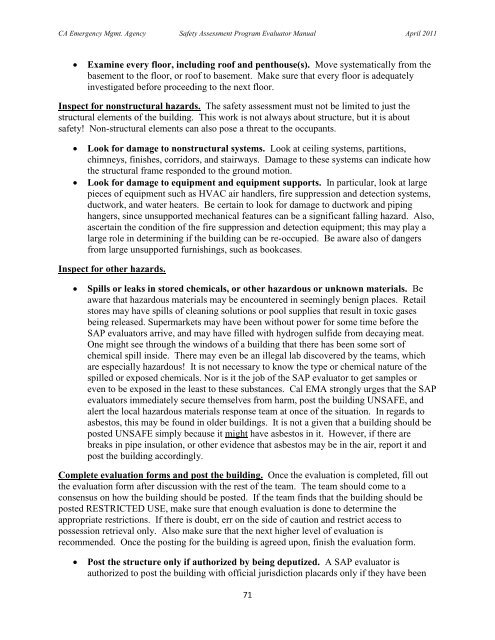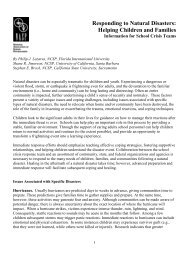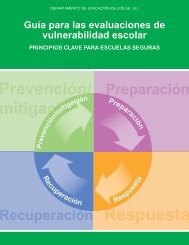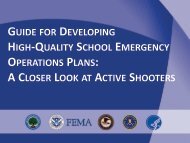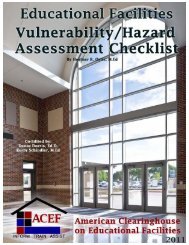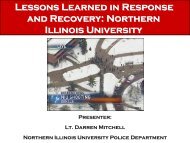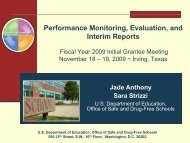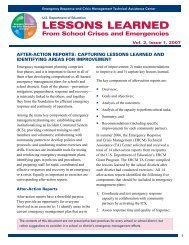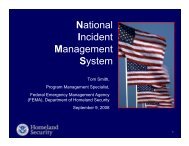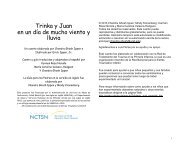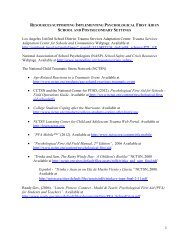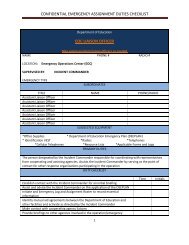Safety Assessment Program Evaluator Student Manual
Safety Assessment Program Evaluator Student Manual
Safety Assessment Program Evaluator Student Manual
You also want an ePaper? Increase the reach of your titles
YUMPU automatically turns print PDFs into web optimized ePapers that Google loves.
CA Emergency Mgmt. Agency <strong>Safety</strong> <strong>Assessment</strong> <strong>Program</strong> <strong>Evaluator</strong> <strong>Manual</strong> April 2011Examine every floor, including roof and penthouse(s). Move systematically from thebasement to the floor, or roof to basement. Make sure that every floor is adequatelyinvestigated before proceeding to the next floor.Inspect for nonstructural hazards. The safety assessment must not be limited to just thestructural elements of the building. This work is not always about structure, but it is aboutsafety! Non-structural elements can also pose a threat to the occupants.Look for damage to nonstructural systems. Look at ceiling systems, partitions,chimneys, finishes, corridors, and stairways. Damage to these systems can indicate howthe structural frame responded to the ground motion.Look for damage to equipment and equipment supports. In particular, look at largepieces of equipment such as HVAC air handlers, fire suppression and detection systems,ductwork, and water heaters. Be certain to look for damage to ductwork and pipinghangers, since unsupported mechanical features can be a significant falling hazard. Also,ascertain the condition of the fire suppression and detection equipment; this may play alarge role in determining if the building can be re-occupied. Be aware also of dangersfrom large unsupported furnishings, such as bookcases.Inspect for other hazards.Spills or leaks in stored chemicals, or other hazardous or unknown materials. Beaware that hazardous materials may be encountered in seemingly benign places. Retailstores may have spills of cleaning solutions or pool supplies that result in toxic gasesbeing released. Supermarkets may have been without power for some time before theSAP evaluators arrive, and may have filled with hydrogen sulfide from decaying meat.One might see through the windows of a building that there has been some sort ofchemical spill inside. There may even be an illegal lab discovered by the teams, whichare especially hazardous! It is not necessary to know the type or chemical nature of thespilled or exposed chemicals. Nor is it the job of the SAP evaluator to get samples oreven to be exposed in the least to these substances. Cal EMA strongly urges that the SAPevaluators immediately secure themselves from harm, post the building UNSAFE, andalert the local hazardous materials response team at once of the situation. In regards toasbestos, this may be found in older buildings. It is not a given that a building should beposted UNSAFE simply because it might have asbestos in it. However, if there arebreaks in pipe insulation, or other evidence that asbestos may be in the air, report it andpost the building accordingly.Complete evaluation forms and post the building. Once the evaluation is completed, fill outthe evaluation form after discussion with the rest of the team. The team should come to aconsensus on how the building should be posted. If the team finds that the building should beposted RESTRICTED USE, make sure that enough evaluation is done to determine theappropriate restrictions. If there is doubt, err on the side of caution and restrict access topossession retrieval only. Also make sure that the next higher level of evaluation isrecommended. Once the posting for the building is agreed upon, finish the evaluation form.Post the structure only if authorized by being deputized. A SAP evaluator isauthorized to post the building with official jurisdiction placards only if they have been71


